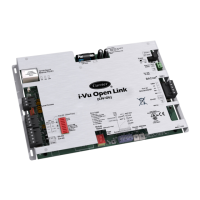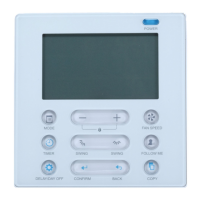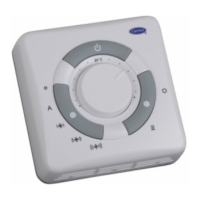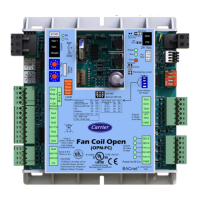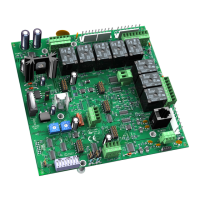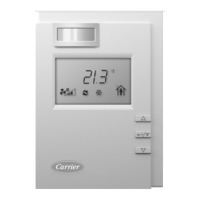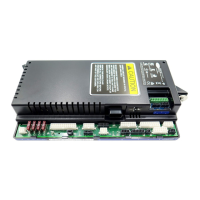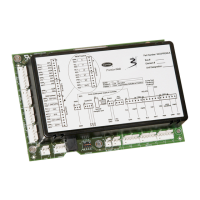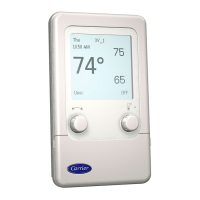SERVICE-- LAST 10 SYSTEM EVENTS
This screen will show last i0 events that occurred throughout the
system. Each entry has the time and date incident recorded.
Service technician should enter current date in "TODAY'S
DATE" menu section BEFORE checking and logging the last 10
system events.
Each entry has a two-letter acronym preceding the event name to
identify which piece of equipment generated the event. This event
history can be cleared under Thermostat Setup, Reset Factory
Defaults.
HP = Heat Pump
AC = Air Conditioner
FN = Furnace
FC = Fan (;oil
SPP = Packaged product
SAM = System Access Module
SERVICE -- RUN / FAULT HISTORY
The indoor unit and outdoor unit (if communicating) have the
following histories:
NOTE: For Critical Fault Screens, see Troubleshooting section in
this document.
RESETTABLE FAULTS:
• Fault counters for each piece of equipment that can be
reset.
CYCLE COUNTERS:
• Number of heat/cool/power cycles the unit has
performed.
RUN TIMES:
• Lifetime hours of operation in heating, cooling, and
how long the unit has been powered.
SERVICE -- TODAY'S DATE
This menu item allows the installer to enter the current date. It is
used for time/date stamping of system faults. This should be
entered every time prior to viewing "LAST 10 SYSTEM
EVENTS" section.
SERVICE -- MODEL / SERIAL NUMBERS
This menu item allows the installer to view the model number
and serial number (if available) of all communicating pieces of
equipment in the system.
SERVICE -- SERVICE PHONE NUMBER
This menu item allows the installer to enter a name and phone
number that the homeowner can call for future service of the
system. This name and phone number will appear to the
homeowner whenever a service reminder pop-up message is
displayed (i.e. Change Filter, etc.)
To edit:
Use Temp +/- button to move cursor left and right.
Use Time +/- button to select numbers and letters.
Use Scroll button to move up and down between
NAME and NUMBER.
OPERATIONAL INFORMATION
CONTINUOUS FAN OPERATION
Pressing FAN button will scroll through the following:
• AUTO = No fan operation except during equipment
operation.
• LOW = Approximately 50% of High Speed operation.
• MED = Half way between High and Low speed
operation.
• HIGH = Highest of either High Heating or High
Cooling CFM.
Continuous fan operation is programmable. The programming
option must be enabled in the Thermostat Setup. See the
Homeowner's Manual for detailed instructions on programming
the fan.
FIVE-MINUTE COMPRESSOR TIMEGUARD
This timer prevents compressor from starting unless it has been
off for at least 5 minutes. It can be defeated by simultaneously
pressing the Fan and Temp + buttons.
EMERGENCY HEAT (FOR HEAT PUMP APPLICATIONS)
To activate Emergency Heat, you must press and hold the HEAT
button for 3 seconds to activate.
KEYPAD LOCKOUT
Keypad can be locked by pressing "Fan" and "Humidity/Oat"
buttons at the same time for 3 seconds. When keys are locked, a
lock symbol will appear in the upper left corner of screen. Follow
same procedure to unlock keypad.
HEAT AND COOL LED
The Heat and Cool LEDs will pulsate during actual equipment
operation.
EQUIPMENT CYCLE TIMER (ADJUSTABLE 4-6 CYCLES
PER HOUR)
This timer prevents the start of a heating or cooling cycle until 15
(or 10) minutes after the last start of the same cycle. Its function is
to assure that the equipment is not cycled more than the selected
times per hour. This timer is adjustable from 4 to 6 cycles per
hour. This timer is defeated for one cycle when the desired
temperature is manually changed. It can also be defeated for one
cycle by simultaneously pressing the Fan and Temp + buttons.
TEN-MINUTE STAGING TIMER
In multistage heating or cooling, this timer prevents any higher
stage from turning on until the preceding stage has been on for 10
minutes.
In duel fuel systems, the staging timer is 15 minutes between heat
pump and gas furnace operation.
THREE-MINUTE MINIMUM ON TIME
In normal operation, when a stage turns on, it will remain on for a
minimum of three minutes. If the set point is changed, this timer
is automatically cancelled, allowing the equipment to turn off
immediately when the demand is removed.
16
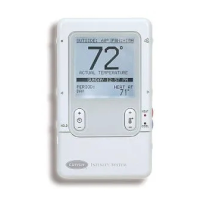
